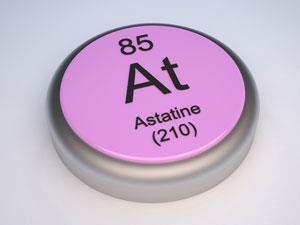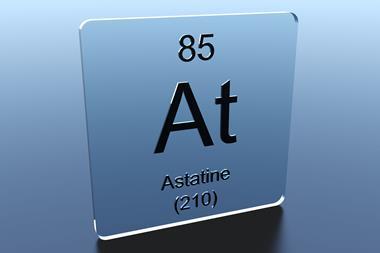
If that ever happens, new first-principles calculations published in Physical Review Letters predict that it will be a metallic solid. That’s perhaps not so surprising given that iodine, the halogen above it in the periodic table, is itself a dark silvery solid (although not truly metallic itself) and that astatine’s melting point is 302oC. But the real surprise of the new results is that the solid wouldn’t be composed of diatomic molecules, like all the other halogens, but would be monatomic. The calculations were performed by Andreas Hermann, now at the University of Edinburgh in Scotland, and veteran theorists Roald Hoffmann and Neil Ashcroft of Cornell University in Ithaca, New York.
Theoretical physicist Yanming Ma of Jilin University in Changchun, China, who has worked on high-pressure solid phases of the other halogens, calls this ‘a wonderful paper.’ ‘The authors present convincing evidence of this surprising behavior of solid astatine,’ he says, adding that the surprise is twofold: ‘its non-molecular form and its metallicity at ambient pressure.’
This behaviour would be easy to miss, because it only manifests when the calculations take full account of the effects of special relativity on the electronic structure of the very heavy atoms: the increase in effective mass of fast-moving electrons close to the massive nucleus. Such effects are known to have significant consequences for heavy elements, famously giving gold its yellow tint and mercury its low melting point.
Importance of spin orbit coupling
In density-functional calculations of the electronic structure of molecules and materials, relativistic effects are commonly split into two components. The so-called scalar approximation considers just the effects of the electrons’ very high speed, whereas their energy is also affected by spin-orbit coupling between the electron spin and the magnetic field created by electron motions around the nucleus. Hermann and colleagues found that a scalar-relativistic calculation predicted a diatomic ground state for astatine, whereas the monatomic form appeared only with spin-orbit coupling included. ‘These effects influence the atoms’ propensity to form certain bonds and crystal structures, usually by reducing molecular binding energies,’ says Hermann. Earlier calculations have indicated that in the gas phase astatine would still form a weakly bound diatomic molecule.
The fully relativistic solid state has no band gap between the valence and conduction electrons: it is a metal even at ambient pressure. In fact, by analogy with high-pressure iodine, the researchers say astatine might even be a superconductor.
Element 117, below astatine, was synthesized in 2010, and would be expected to experience even stronger relativistic effects. ‘My guess is it would be a weakly bound monatomic metal,’ says Hermann. ‘But I’m ready to be surprised.’
Whether the predictions will ever be tested experimentally remains to be seen. Astatine generally has to be synthesised artificially by nuclear reactions – it was first made this way in 1940 by scientists at the University of California at Berkeley. It is so radioactive that a lump of solid astatine would be vaporised almost instantly. But Hermann remains optimistic. ‘With active cooling of the substrate one might be able to stabilise a thin film for a sufficiently long time,’ he says.







No comments yet